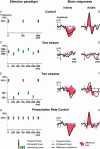Newborn infants can organize the auditory world
- PMID: 14500903
- PMCID: PMC208846
- DOI: 10.1073/pnas.2031891100
Newborn infants can organize the auditory world
Abstract
The perceptual world of neonates is usually regarded as not yet being fully organized in terms of objects in the same way as it is for adults. Using a recently developed method based on electric brain responses, we found that, similarly to adults, newborn infants segregate concurrent streams of sound, allowing them to organize the auditory input according to the existing sound source. The segregation of concurrent sound streams is a crucial step in the path leading to the identification of objects in the environment. Its presence in newborn infants shows that the basic abilities required for the development of conceptual objects are available already at the time of birth.
Figures

References
-
- DeCasper, A. J. & Fifer, W. P. (1980) Science 208, 1174–1176. - PubMed
-
- Bregman, A. S. (1990) Auditory Scene Analysis: The Perceptual Organization of Sound (MIT Press, Cambridge, MA).
-
- Leslie, A. M., Xu, F., Tremoulet, P. D. & Scholl, B. J. (1998) Trends Cognit. Sci. 2, 10–18. - PubMed
-
- Demany, L. (1982) Infant Behav. Dev. 5, 261–276.
-
- McAdams, S. & Bertoncini, J. (1997) J. Acoust. Soc. Am. 102, 2945–2953. - PubMed
Publication types
MeSH terms
Grants and funding
LinkOut - more resources
Full Text Sources

